
What is the Missing Middle?
Other than he is my total hero, and he was born and he was raised in my hometown, I wanted to interview John Romero to try and solve the modern indie game development paradox.
The paradox goes like this…
When John Romero was making games In the 1990s there was no digital distribution so you had to get a company like Softdisk to publish you and physically manufacture and distribute your games by mail! There was no Unity, Gamemaker, Godot, or Unreal so if you wanted to make a game you had to have a full-time person (in their case John Carmack) crafting your game engine from scratch (usually in C or machine code) every time. There was no widely accessible internet or cloud-based source-control or storage so you couldn’t work remotely.
Yet, despite all the limitations of the 1990s, the guys at id Software could make 13 games in 1 year.
How is it that we have better tools which should make us more productive, and better communications that should increase collaboration, and digital distribution which has, essentially, 0 marginal cost, and yet games take longer to make? Indie game developers were supposed to be small, nimble, and quicker than the hulking, slow moving AAA goliaths. What happened?
IMPORTANT: this is not a lazy devs argument! Everyone is working their ass off these days. My concern is that when I talk to first time game devs they almost always tell me they are 2 years deep into their 4 year project. That scares me!
In today’s post I want to explore why new indie game developers plunge themselves into much longer game development cycles. The industry has essentially stretched us to cut out one of the most important stepping stones between tiny games and multi-year projects. This has caused developers to have incorrect assumptions, wasted resources, and burnout.
(Also I wanted an excuse to write a post that included as many pictures of the Doom guys wearing jorts as possible)

My theory: The missing middle
The modern indie game business model and development process has a missing middle problem.
For the last decade or so, the business model of first time indie studios goes something like this:
“We are a team of 3 developers and did a game jam, published it on itch.io, had fun, people seemed excited for our game, so we formed an LLC, signed with a publisher, and are planning to spend 3 years making our first game for which our goals are modest: we really only want to make $300,000.”
That mentality right there is the missing middle problem: These days, studios either make jam games that they hammer out in a weekend that they post to itch for free or they burn the ships, quit their job, and make multi-year mega projects that can only be profitable if they earn multiple hundred thousands of dollars.
What is a middle game?
These are games that are bigger and more polished than a game jam game but are not huge, 30 hour epic triple-I indie game. A “middle game” should only take 1 to 9 months to create and can be profitable (or at least not a money sink) because it is expected to earn in the range of $10,000 to $40,000.
“Middle games” used to be the norm. The middle used to be the goal. The middle was how you built a career.

But now, to the modern indie dev business model, (especially the ones hanging out on r/gamedev): earning $40,000 or less is considered a complete failure and should be mocked publicly (this is them speaking, not me).
To the modern indie dev business model, dedicating just 3 months (or less) to your first project is shocking and when I say that they react as if I am asking someone to perform a backflip to the moon or to change their blood type using transcendental meditation.
I believe the modern indie business model that skips over developing “middle games” is why 75% of studios on Steam have released 1 and only 1 game.

Why did this happen?
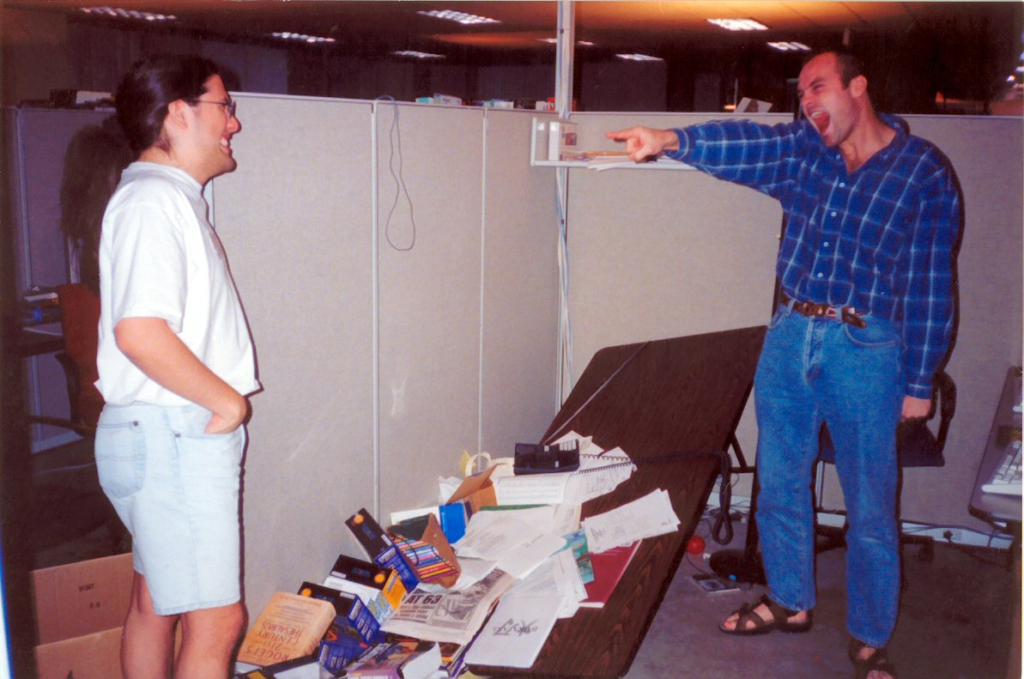
Indies stopped developing “middle” games because the industry stopped directly paying for them.
Quick history lesson:
In John Romero’s book Doom Guy, the first time he was paid for making a game was an Apple II game he published called Scout Search for inCider Magazine. The magazine paid him $100 for it ($300 in 2023 dollars).
Here is a picture of the magazine:
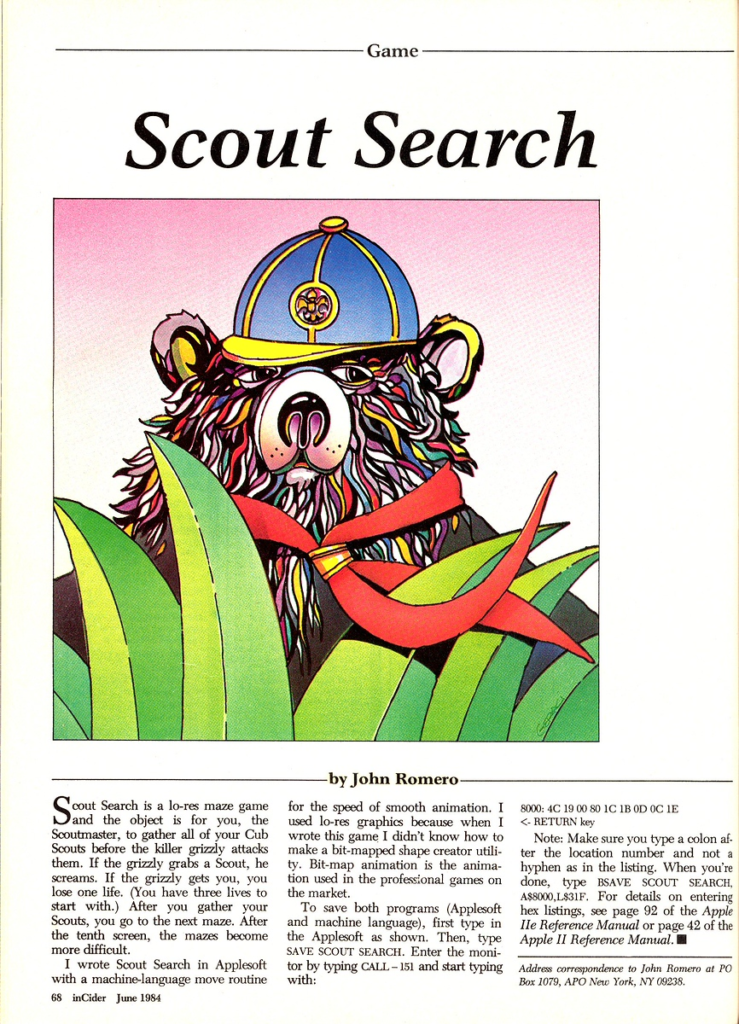
(side note, get it? It is an Apple computer magazine called inCIDER? Get it?)
Here is a picture of the game:
For early indie software distribution, magazines would literally reprint source code and people would retype that code into their computer to play the game. Obviously the games had to be tiny enough to be printed in a magazine and be manually retyped by a human. The payout was in the hundreds of dollars. But that was what the expectation was at the time.
Softdisk, the company John worked for before starting id Software, would pay developers a flat fee to the rights to ship their game on their monthly software disk. Softdisk negotiated a 6-game deal with John’s id Software for $5000 per game (about $11,000 per game in 2023 dollars). That was the expectation for games at that time.
In the days of flash games, flash portals like Kongregate, Armor Games, and Newgrounds paid indie game developers a flat fee to have their logo embedded in their game. For a decent game flash portals paid indies in the range of $10,000 to $30,000 ish dollars. That was the expectation for games at that time.
Back in the day, there was an income ceiling to indie game development. Publishers paid a small flat fee per game. Nobody was getting rich off one game, so developers were incentivized to make lots of games that were small, quick, and fun.
Back in the day, making a game and earning $15,000 from it was totally expected. Nobody said “FAILED GAME!” Nobody called it the indiepocalypse. That was just what games earned.
Here a quote from flash game developer who used these smaller games and eventually became a hit Steam developer of games like Coffee Talk:

I would make the art and a friend would do the code. We could make a simple game in a week and that could sell for $500 in sponsorships. We made the first Infectonator game in a month and that game got $5000 in sponsorship + $20K in performance bonuses. Some sites would offer performance bonuses where they would reward based on how many times the game was played, more plays means more ads traffic for the sponsor. It’s basically revenue sharing from the ads that the game generated in the sponsor’s site. We learned a lot about game design from those Flash days
Kris Antoni (Toge Productions
You can still play infectonator here.
Earning ONLY $25,000 for a game sounds terrible now, but when your game is made in a week, “middle games” were a great way to learn game development and build a career.
“Middle-earning” games are still the norm people just don’t realize it
Gamalytic recently published a blog post that did some filtering to see what the “true” median income for Steam is. They filtered out cheap asset flip games that cost less than $5 and found that the median revenue is about $4000.
They also filtered out games that cost less than $10 and found the median revenue is $17,000.
$17,000 in today’s dollars is basically what Softdisk was paying id Software per game back in 1990
And actually, the number of games that have earned $10,000 in the first 3 months is growing!

Graph from Gamalytic
So why is it so bad now that games earned $10,000 when 30 years ago it was the norm? Because now there is a slim chance to become super rich because of the indie-utopia.
The birth of the Indie-utopia
Everyone complains about the indie-pocalypse but not enough people consider that we just lived through an indie-utopia in the form of digital distribution and mega-earning games.
In 2004, digital distribution arrived to consoles with the original XBOX’s Xbox Live Arcade. Games like Geometry Wars were HUGE and earned millions.

For PCs, digital distribution always sort of existed but it kicked into high gear in 2005 when Steam opened up to 3rd party games. The first non-Valve game to appear on Steam was Ragdoll Kung Fu which you can still purchase today (it only has 53 reviews).

With the birth of digital distribution, suddenly a game produced by indies COULD earn millions of dollars in sales (emphasis on “could”) instead of just earning $10,000 paid up front by some platform like Kongregate. That documentary Indie Game The Movie almost seems like Xbox Live propaganda telling developers that YOU WILL make millions of dollars.
Then in 2007 with the birth of the iPhone, and 2008 with the app store, and the Free To Play model, the flash game portals were dead. And without flash, nobody was paying developers a flat rate to make smaller games. Free To Play, and ad-supported games could also make MILLIONS OF DOLLARS. When Flappy Bird hit in 2014, everyone was whispering about how the developer was earning $50,000 per day in ad revenue. Numbers like that make the $10,000+ ceiling that flash portals paid out seem laughable.
What developer would want to settle for $10,000 when they could earn 100 times that?
AAA became huge
At the same time that indies were getting million dollar payouts, AAA games flourished too. Games like Call of Duty, Bioshock, Grand Theft Auto, Skyrim, The Last of Us, and Dark Souls became mainstream. Games became more profitable than movies.
People stopped going to arcades to play silly little action games. Instead, people could play beautiful AAA games at home on their consoles and PCs.
Simultaneously, the Free to Play model changed game design so that retention was the most important metric. Free to Play would exploit quick hit arcade-style games like Bejeweled or Frogger and then bolted on a massive retention systems in the form of upgrades, powerups, and muli-currency schemes and birthed complex chimeras like Candy Crush and Subway Surfers.
So quick hit arcade games (like John Romero published for inCider magazine) were no longer in vogue.
Since 2001 with the XBOX and PS2, AAA games have become so amazing and so beautiful and so ubiquitous that an entire generation of gamers have grown up assuming that a game = 10-15 hour linear, cinematic experience with amazing graphics.
Those young gamers who later became developers never had the chance to play silly little games that are worth about $10,000.
They never had a chance to experience what a “middle game” is.
Platforms, publishers, and investment firms grew up too
When the rest of the industry started earning million dollar payouts, the 3rd-party businesses that funded the middle market grew up too.
I keep my ear to the ground and most major indie game publishers and platforms (like XBOX Game Pass) won’t even consider funding games for less than $200,000. In fact I have heard about indies pitching the big publishers $250,000 budgeted games and the publisher coming back saying “Increase your budget and how much you are asking for and MAYBE we will publish your game.” So developers scaled their game up, doubled how much they were asking for and then they got funding.
Publishers want to see big payouts and they know that only comes from big budget games.
The original game that indie developer pitched was totally fine before that publisher asked the developer to bloat the budget. The game would have probably been even better if they just left it at the size it was originally.
Publishers don’t have time to fund and support a game that is expected to earn $17,000 revenue. If the publisher negotiated a 30% revenue split that means that after Steam’s cut, taxes, etc, they would be earning less than $3500. That just doesn’t scale for publishers so middle tier games are worthless for them.
The exception became the rule
When games had the possibility of earning developers millions, every developer mentally EXPECTED games to do that well. Our expectations became outsized and distorted.
I am guilty of distorting this expectation too. I mostly write about games that are top sellers such as Dome Keeper, Peglin, Zero Sievert. To be fair, I do sometimes cover games that are medium hits. Such as Ravenous Devils, and all these more modestly selling opportunities.
We forgot how to make small games

Basically when developers MIGHT earn millions of dollars from an indie game, everyone gets that number in their head as the EXPECTATION for releasing a game. Every game that doesn’t earn $1,000,000 must be a failure!
If you step back, the expectations that contemporary developers have for themselves is really is quite insane:
Step 1: Try out a concept with a game jam game that you made in 2-5 days.
Step 2: Dedicate 3+ YEARS of your life to create a flawless masterpiece that will earn you $1,000,000.
If you mess up Step 2, you wasted 3 years of your life and FAAAAAAAILED
This is crazy.

(BTW Why does everyone on r/gamedev use the term FAILED so readily? Stop it).
What we can learn from our forerunners and the birth of id Software
My favorite sci-fi trope is when scientists uncover an ancient alien civilization that was super advanced but somehow managed to implode and the scientists dig up their lost ancient machinery so that we can learn from their long lost genius (see the Alien franchise film Prometheus, 2001 A Space Odyssey, Halo etc).
We need to go back.
Basically we need to dust off the id team’s jorts and figure out how to make smaller games in faster timelines (John Romero isn’t even that old so it shouldn’t be that hard to get back at it.)

Here are some lessons I think we can learn from our game dev forerunners:
Set expectations
Build your game assuming you will earn $10,000 NOT $1,000,000. How long should you build it with that goal? How much should you spend on art? What creative compromises will you make?
Limits create great art.
Expect to release multiple games per year
Yes, it can be done. You don’t have to release 13 like id Software did in 1991 but you can release more than 1 game per year.
Be aware of the market
I know it is uncool to make market-based-decisions that compromise YOUR TRUE ARTISTIC VISION (man) but successful developers have always done that.
John Romero worked for Infocom and had experience making huge RPGs. He also loved deep RPGs like Chrono Trigger and Ultima. The guys at id Software played a lot of Dungeons and Dragons (John Carmack was the DM). But when John Romero co-founded id Software, he knew his small team couldn’t create deep, story-rich RPGs, so they purposely chose not to.
Similarly, despite early success with 2D platformers like Keen and Dangerous Dave, by 1991, Romero knew that the industry was transitioning to 3d games. So id Software changed their strategy to keep up with the times.
“Guys, we should not be doing this game. We have this cool technology that we’re not using, that we’re not taking advantage of to make a better version of that game going forward.”
John Romero to his id Software team, trying to convince them to give up 2D platformers and transition to 3D games
id Software could have spent YEARS heads down working on their magnum-opus game DOOM with the most advanced tech. But they didn’t have the runway, or the capital, or the expertise, or the audience to do that yet. Instead, they released several smaller games each one built on the same engine but with a slight improvement over the previous one. This allowed them to earn money while they researched better tech.
Spread research and development across several games
Here is a brief history of games made by the id Software team that demonstrates how they used multiple releases to incrementally upgrade their research.
Catacomb (Play it here in browser)
Released 1989. This was John Carmack’s early 2D game for Softdisk. Here the basic gameplay is established such as basic dungeon crawling (aka Gauntlet) and attacking enemies with a weapon where you hold down the fire button to charge up. There are also keys, potions, spells, etc.

HoverTank 3D (Play it here in browser)
Released 1991, this is the first real 3D engine id Software created. Notice that HoverTank’s walls are all solid colors? At the time they didn’t know you could scale bitmaps to create textured walls. But who needs textures!?! Also the controls kinda suck and don’t feel responsive. But the basic UI is innovative for the time: it includes a radar that shows you where the enemies are (which is still used to this day in FPSs)

Catacomb 3-D (Play it here in browser)
Released in 1991. This game builds off the HoverTank engine and adds textured walls (look at that cool brick pattern). The game also has improved controls, multiple weapons, keys, healing potions, and a new compass which is still used in modern FPSs and games like Skyrim.
But notice that Catacomb 3-D still has the same basic game design as Catacomb 2D. It is still dungeon crawling, there are Bolts, Nukes, Heals, Keys and is score based just like the 2D version.
Also notice how the team has basically the same red brute sprites between HoverTank and Catacomb; they just gave them yellow eyes and toenails.

Wolfenstein 3D (Play in browser here)
Released 1992. This is built on the same 3D engine as the previous games but now has VGA graphics instead of the smaller color palette of the EGA graphics that Catacomb 3-D used.
Wolfenstein also added other gameplay mechanics such as secret walls, better weapons, and the ability to add sound triggers to the map that can alert remote guards when you shoot.

Doom (Play it in Browser here)
Released in 1993 This game truly revolutionized the industry. It was built on an entirely new engine that incorporated everything John Carmack learned making HoverTank, Catacomb-3D, and Wolfenstein 3D. The game finally featured diminished lighting, sky textures, variable height floors, non-orthogonal walls and even a head bob when you run.

Basically DOOM was not a game that came from thin air. It was built slowly over years through smaller releases, feedback from the marketplace, and constant iteration.
If back then id Software used the modern indie all-or-nothing method of production they would have gone silent for 3 years with no market feedback, no funded R&D on their engine, no practice in 3D level design, no building an audience. It would have been designed in the dark and may have never been discovered or even made it to release.
Reuse tech infrastructure
Throughout the development of their dozens of games, John Romero created Tile Editor aka TED which was id Software’s in-house editor to create levels for many of their games. The editor was flexible enough that it could be reused over and over despite each game having slightly different engines. Over the years the tool created levels for their 2D platformer Commander Keen or simple 3D games such as Wolfenstein 3D. John Romero commented in this tweet that over 33 games were made using his TED v5 tool.
TED was even used by other companies to make levels for their games. Here is a screenshot of TED being used to make levels for Apogee’s Rise of the Triad.
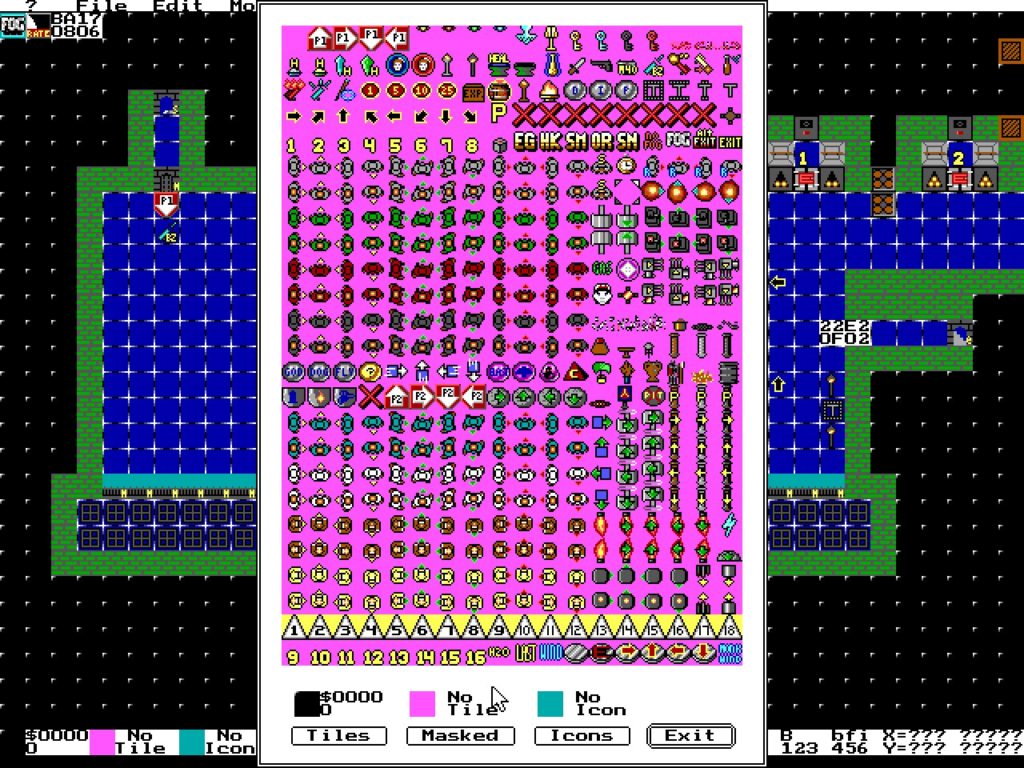
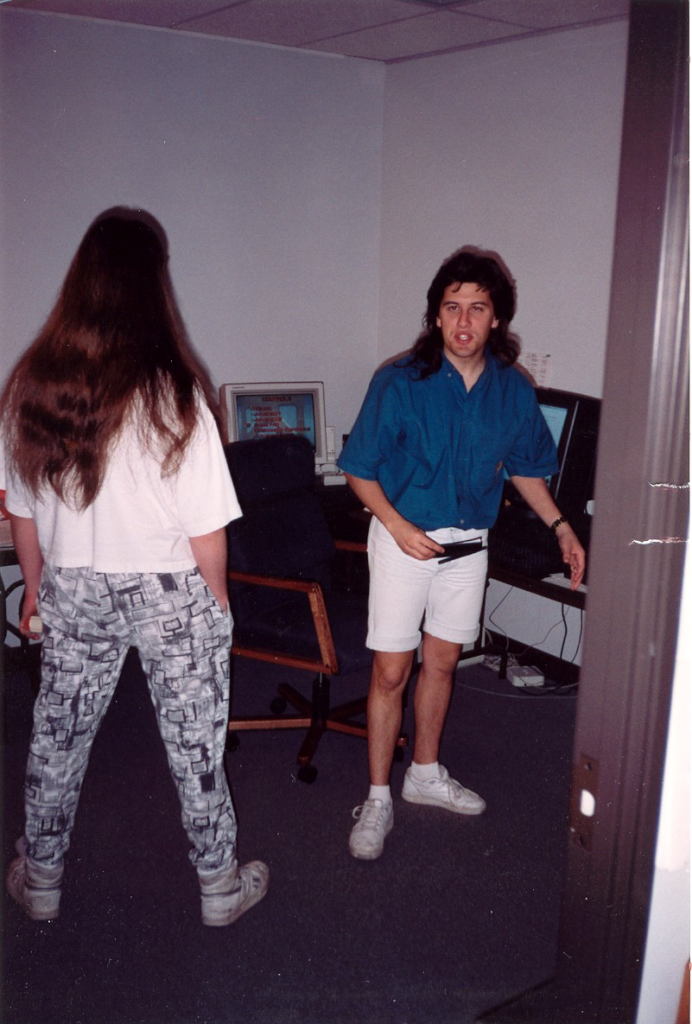
The great Jorts vs Hammer-pants debates. The daily dilemma everyone in the 90s faced.
Learn what a small game is
Whenever I give a talk and say more indies should make a game in 6 months, people’s heads explode. They leave nasty comments on the Youtube video. IT’S IMPOSSIBLE!
AAA games have warped our brains as to what the scale of a game is. Blockbuster indie games like Hollow Knight and Factorio have warped our brains as to what the scale of a game is. You cannot make those games in the short runway needed for “middle” games.
We don’t even remember what small fun games feel like anymore. So I am going to show you REAL WORLD examples of actual indies who have actually made good quality, moderately profitable, non-asset-flip, games.
Your homework assignment is to download these. You should play them. We need to relearn what “middle games” feel like.
Now you might look at these games and say “Chris this game FAAAAAILED it only earned 123 reviews!” Remember, we are living in the land of “Middle Games.” If you only spend 3 months on a game, 123 reviews can mean the game is quite profitable on a per-hour devtime.
Real world, middle sized games
Cozy Bee
I am such a fanboy of Cozy Bee games. Most of the games by this 1-person team are developed in less than a year. Here are a few of them. They are in the right genre for Steam (management), they have the right graphical style (cozy), they are just so smart.

20 Minutes Till Dawn
I wrote about 20 Minutes Till Dawn in my blog post here. Ignore the fact that it made millions of dollars, the interesting thing is that it was initially released after fewer than 3 months of development time. 20 MTD was a “middle” break from a game that the developer had been working on for YEARS. Middle games to the rescue to stop burnout.
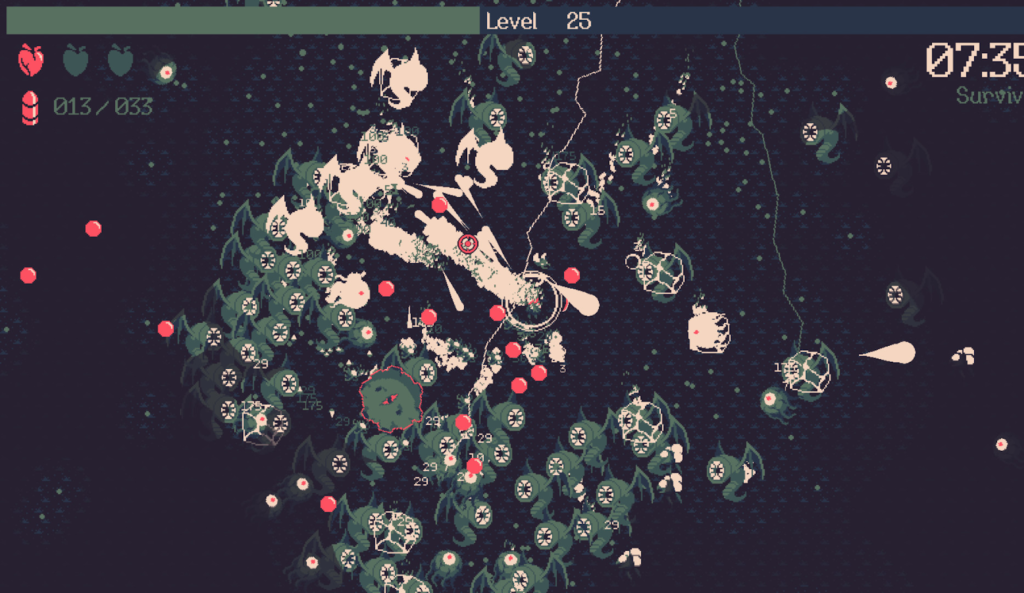
Sokpop
The Sokpop collective releases a game a month. Behind the scenes they are really four developers who work alone releasing their games typically after a staggered 3-month dev cycle. They have their own way of doing things and I would say go a bit too crazy switching up genres too fast and not doubling down on proven genres which is why you see such variation in their sales numbers. But who cares? They seem to be having fun and they are still releasing interesting art, so good on them.
If you look at their titles, you will notice that their most successful games are the ones in Steam’s preferred genre: Crafty-buildy-strategy games. Those are
The less popular ones are typically platformers, linear narrative games, and super experimental avant garde genres.
Luck Be A Landlord
This anti-capitalist slot machine roguelike was a hit! But it didn’t have to be be due to the short production time.
I asked developer DiIorio about the development process:
The first public build of Luck be a Landlord took about 2 months from its initial concept to the demo release in the Steam Game Festival: Autumn Edition.
I originally was working on it for this game jam: https://itch.io/jam/lowrezjam-2020 before I expanded it into a bigger project.
Dan DiIorio
You can see his original tweet here:
SNKRX
SNKRX was developed in months and you can actually follow along the developers process with this day-by-day dev log and more game marketing and making thoughts on their main blog.

SNKRX, and Vampire-survivor likes are a great example of one way to make quick games that Steam actually pays attention to is to take a classic old arcade game or flash game and add a roguelike meta progression on top of it.
City builders
City builders and civilization style games are the biggest genres on Steam but developers always say “Well those take YEARS to make.” But they don’t have to take long if you focus on finding what the fun actually is behind them and stripping away everything else. A perfect example of this is Islanders which is a minimalistic city builder that took the team only seven months to develop.

Horror games
Horror games are a very very popular genre with gamers on Steam and this developer made Backrooms Apprehension and Don’t Look Away in 1.5 months each.
Here is a quote from them on this reddit thread.
“I’ve made two games so far (DON’T LOOK AWAY and BACKROOMS:APPREHENSION), they took me about one month and a half each, still updating them but I did release them in early access and they are doing pretty good, not millions but that wasn’t my goal, I just needed to make enough to quit my job and to allow me to keep making games and I’ve succeeded.“
DMNT Interactive

But Chris! You wrote earlier that Steam hates small games!
That is correct! 2 Years ago I said that the Steam algorithm is built to hide smaller games (See even Steam is built to suppress the “missing middle”)
It is true that you cannot rapidly release many small games and expect to make millions. But that is ok. Remember, our brains have been AAA and III warped. Indie Utopia warped our brains.
The whole point of middle games is to improve your tech, get your name out there a bit more, build a back catalog, practice launching, and just have some lower-stakes fun. If your game that took 3 months to build did fail, don’t worry, you only wasted 3 months. Move on to the next game. If you do meet the target of $10,000 revenue, that is awesome! If not, make another one.
You could go to game design school and pay them TENS OF THOUSANDS of dollars per semester to learn how to make games, or you could just release a bunch of small “middle games” and EARN tens of thousands of dollars. When John Romero and id Software released HoverTank and Catacombs 3D they didn’t say “our games failed, we only made $5000!” Instead, they saw it as paid R&D that was equity towards developing Wolfenstein 3D which earned id Software $50,000 per month a year later.
Podcast
Bonus: Designer Notes Podcast. While I was writing this, Soren Johnson published this great interview with Trent Kusters about how his early days working at a company that would churn out games and he talks about how much he learned from that experience
Failure is ok
Even if the game does “fail,” you shouldn’t be ashamed. Watch this great segment from an interview with fine art critic David Sylvester saying artists “must be allowed to go through bad periods, they must be allowed to do bad work.”
Don’t worry, the rapid, quick, middle game period is just the middle. You will someday make your big grand masterpiece, you just can’t do it right away.
Stick with it and you can make your masterwork some day.
Final Inspiration
I want to leave you with one final picture of John Romero in jorts and long sleeve denim (long on the top, short on the bottom) and the most inspirational part of his book:

Start small and get some practice. Try remaking a classic arcade game to get a feel for things before you attempt to make a giant RPG. Carmack, Tom, and I had each been making games for ten years before we started working together. It was another few years before we made DOOM, and that was my ninetieth game (not a typo). Give yourself time to get good, and don’t be dissuaded by setbacks. Game development is like gameplay. Load your save and try again.
John Romero Doom Guy